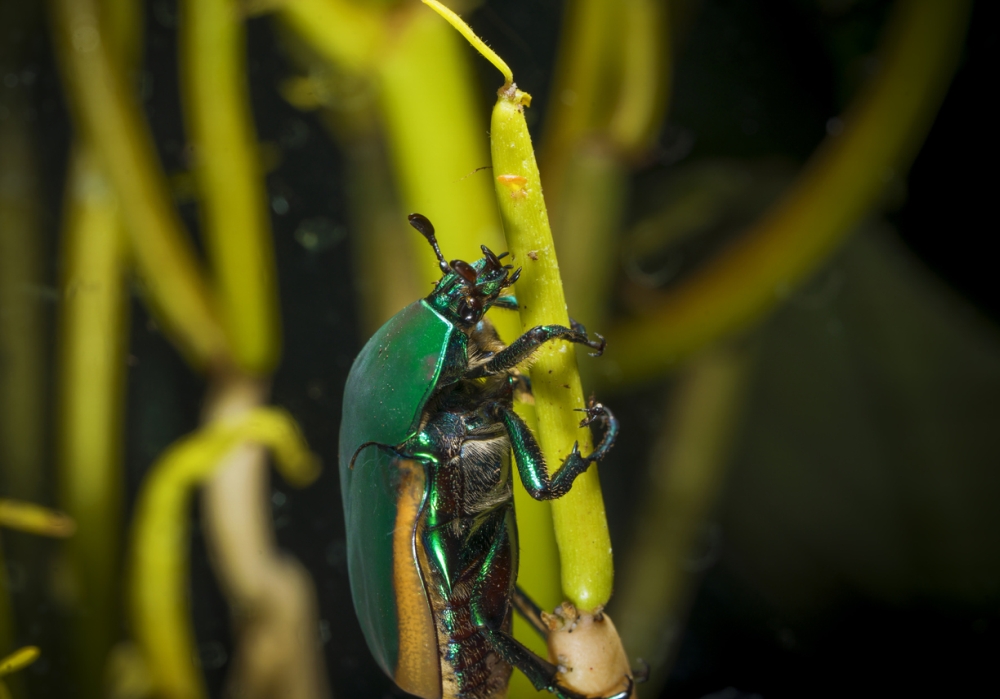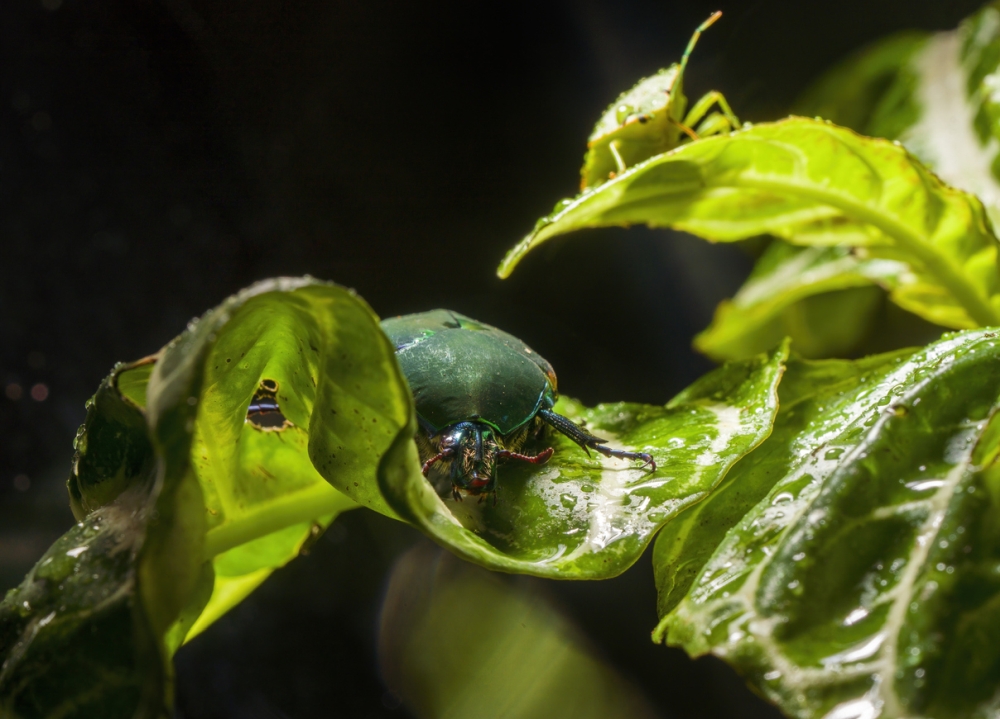How to Spot & Control Figeater Beetle Infestations
When it’s summer, we all dread the struggle of dealing with Figeater beetles that like to hum around fruits before harvesting? I’ve heard my terrible share of experience when caring for my fig trees. If you have fig trees in your garden, then you’ve probably had to fight a number of flying pests, including some green and huge flying beetles often referred to as figeater beetles. Well, these beetles are not really Fig eaters—their scientific name is Cotinismutabilis,and are members of the scarab family.
These pests are also known as green fruit beetles and like to eat the fruits of the fig tree. They are called beetles because of their resemblance to brown beetles. These creatures will lay eggs on your fig tree and you’ll have a terrible time trying to get rid of them.
What is a Figeater Beetle
To spot a Figeater beetle, you want to look out for flies that are about an inch long and have dark metallic green, with coppery wing covers. They have copper-colored head capsules and the antennae are black with white bands around them. Figeater beetles infest massively by laying eggs that develop to larvae—a pale yellow or white, legless grub that measures about an inch long when fully grown.
Adults emerge in the summer months and feed on the leaves of deciduous trees like the Figtree, and shrubs such as apple trees, sweetgum, flowering cherry, lilac, and others. You might confuse these buzzing pests with the Japanese beetle. Although both prey on plants, the figeater prefers fruits while the Japanese beetle prefers leaves and flowers. Figs are the perfect food for figeater beetles.
That’s because the beetles lay their eggs in the figs, and when they hatch, momma beetle feeds them from her body fluids until they’re completely grown up and ready to mate. Figs are also high in sugar because their rich in potassium nutrients that require a lot of water osmosis to break down—and that’s where these flying pests get all of their energy.
Figeater Beetle: More About its Life Cycle
The figeater beetle has a wide ecological range and is one of the top pests that figs are prone to in many parts of the world. They have a preference for old or unhealthy trees because they can weaken them by sucking tree juices. The secretions from their mouths are an irresistible sugary treat to small mammals that contaminate their population. This provides a safe habitat for the perfect breeding ground for their progeny.
Fig eaters are also capable of surviving in extreme climates that other pests wouldn’t survive in such as freezing temperatures, hot temperatures, and drought conditions which is why they are considered to be some of the most resilient pests known to man.As you probably know, the eggs are laid in the summer while figs are ripening. The eggs have a long incubation period of nine to 11 months and once they hatch, the larvae burrow into the tree. The beetles feed on the vascular tissue of young leaves as well as sweet sap until they mature and form pupae that overwinter inside hollow portions of the fig.
Meanwhile, adults emerge from these pupae during warmer temperatures because food is at its highest point during this time of year.Fig eatersare also known to survive up to 30 days without food so long as their body functions remain normal and they avoid air temperatures over 70 degrees Fahrenheit.
What Damage do Figeaters Cause?
The damage caused by fig eaters can be devastating—although not to the extent which other pests such as aphids or scale insects reach. They can cause a tree to become so deficient that it will be unable to produce fruit the following year, typically causing a 30 percent reduction in yield. They also have been reported to injure or completely destroy the roots of the tree over time.
When fruit production goes down due to an infestation, it makes it difficult for pollination to take place and the fruit will have reduced quality or not ripen at all. If you have a figeater beetle infestation, you’ll notice that leaves are damaged along with sweet sap oozing from them which is where the insects feed on. You’ll also notice leaf curling, twisting, or browning of the tree at some point.
How to Control Figeater Beetles
1# Harvest their food source
If you have figeater beetles in your yard, you can remove their food source by trimming tree branches near houses, keeping vegetation from touching windowsills or eaves, raking all leaves on a regular basis, and washing down outdoor furniture with a mild bleach solution before storing it for the winter months. The best way to harvest figs is to wait until they have ripened when the fruits are sweet and delicious. You can tell when a fig is ripe by gently squeezing the neck of the fruit; if it moves easily, you can pick it without worrying about bruising.
If you don’t want to wait, the simplest solution is to use insecticidal soap to kill the insects that are already on the fruit or place a few drops of dishwashing liquid on a paper towel and rub it into the fruit’s stem. To ensure that all insects have been wiped out, throw away any ripen fruits.
2# Suppress the Figeaters at their Larval stage
One of the most suitable times to control figeater beetle infestations is when they’re at their larval stage. At this phase, they’re usually vulnerable to the surrounding conditions. The larvae tend to spend fall and winter under bark on fruit trees. They also live next to dying tree roots and just below the surface of the soil. It is most often in early spring when tree sap starts running again, that figeater beetles emerge from their larval stage and start to climb up into trees.
In this time period, fig eaters can be killed by applying a suffocating treatment which kills them at the larval stage of development. And this is especially important when the infestation is at its premature stage. At this stage, the larvae would also be living below the surface of the soil and inside old decaying tree roots or bark. It’s, therefore, necessary to clean up any debris that might harbor these pests so that there is no place for them to hide. Worms and flies are the other predators that also feed on the larvae and that would help control these pests.
3# Use Sticky Traps
Figeater beetles are attracted to the sweet sap of fig trees and will travel as far as 300 meters to find one. It’s no wonder why they also seem to prefer citrus trees or fruit trees like apple or peach. Traditional traps and baits have been used by gardeners to control these pests for quite a while. Sticky traps are made out of a pesticide impregnated adhesive which is placed on a board designed for easy reuse. The beetles get trapped, making them easy to dispose of. Using physical barriers such as insect nettingcould help protect your figs from moths, insects, and birds. But, if you don’t have any insect netting, a sticky trap can be placed over the top of your fig clusters to help keep these bugs at bay.
The catch is that there are two options for sticky traps. One type is available in supermarkets and gardening centers, but it will not last very long because they are made of paper. These traps are also pricy and need to be replaced regularly. The other option is to make your own with items you have on hand around the house or with items purchased from a store. Making your own version of these traps will save you money, as well as give them a longer life span.
4# Hand-pick the bugs if you spot them
One quick remedy to control the fig eaters is hand-picking them manually on your plant. Make sure you get any eggs on the plant as well. You can inspect the leaves by turning them upside-down, then get rid of any visible bugs. You can also use natural predators like ladybugs to control the population of fig eaters in your fig trees. The ladybugs will eat all the eggs they find, so your plants should stay safe from infestation for at least one year after releasing them into your garden. However, it is important to know that too many insects in one place might still cause damage if they infest the largest part of your foliage.
5# Use Organic Non-Chemical Pesticides
The first step in using your organic non-chemical pesticide is to get a sprayer and get it thoroughly sterilized, to weed out the chances of infecting the fig trees with other diseases. Next, you will need to dilute the organic insecticide according to the instructions on the label. When using insecticides, you want to spray the entire tree and preferably every 6 months if you have a low infestation. Another thing you want to make sure of is that all the branches are covered with the pesticide, as not all insects live on the leaves.
The most important thing about organic insecticide is that it must be applied when the pest population is at its maximum, this is usually in late spring or early summer—when fig eaters are active—to make the remedy a lot more effective. If you choose not to use an organic non-chemical pesticide then it’s best to do a thorough inspection of your fig trees and spray them when a heavy infestation has been detected. Another natural remedy would be to use diatomaceous earth. It doesn’t ruin the texture or soil composition of the soil and helps get rid of root weevils which figs are also highly prone to.

